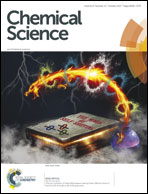Dearomatization of electron poor six-membered N-heterocycles through [3 + 2] annulation with aminocyclopropanes†
Abstract
Many abundant and highly bioactive natural alkaloids contain an indolizidine skeleton. A simple, high yielding method to synthesize this scaffold from N-heterocycles was developed. A wide range of pyridines, quinolines and isoquinolines reacted with donor–acceptor (DA)-aminocyclopropanes via an ytterbium(III) catalyzed [3 + 2] annulation reaction to give tetrahydroindolizine derivatives. The products were obtained with high diastereoselectivities (dr > 20 : 1) as anti-isomers. Additionally, the formed aminals could be easily converted into secondary and tertiary amines through iminium formation followed by reduction or nucleophile addition. This transformation constitutes the first example of dearomatization of electron-poor six-membered heterocycles via [3 + 2] annulation with DA cyclopropanes.
![Graphical abstract: Dearomatization of electron poor six-membered N-heterocycles through [3 + 2] annulation with aminocyclopropanes](/en/Image/Get?imageInfo.ImageType=GA&imageInfo.ImageIdentifier.ManuscriptID=C7SC03197A&imageInfo.ImageIdentifier.Year=2017)


 Please wait while we load your content...
Please wait while we load your content...